Have you ever heard of Birding before? Neither have I, but it seems to be a variation of Bird Watching. Research indicates that some of the key differences between the two are that Bird Watching requires a person to go into the field to observe birds in their natural habitat for a few hours on a particular day as opposed to Birding, where a person’s lifestyle includes observing birds regularly. Some birders keep a list of every bird they’ve ever seen in their life and are very familiar with their local birds. Today, we’ll be looking into the tools, techniques, and the benefits of Birding. Welcome to Birding 101.
If you’re looking to get into Birding, it may be good for you to study the various types of species and terminology before beginning. Listen to recordings of bird sounds, calls, and songs. You may want to begin by limiting yourself to only listening to birds of your region first and then gradually expanding. Pay attention to local birds on your commute, in your neighborhood, and outside your window. Try to make time to look for birds. Birding allows you to engage with your surroundings and make your experience more memorable, but you need take action to make it happen.
A common problem in Birding is struggling to identify certain birds. You should practice using quality binoculars like Celestron Nature DX or Nikon Monarch 5. They are very useful tools in helping you spot birds. Don’t settle for cheap binoculars unless you absolutely have to. Once you get a pair that works for you, pre-focus them with the diopter properly set. Practice jarring and abrupt movements so when you’re in the field, you’ll be more comfortable in action. You may also want to consider a trade-off such as weight when it comes to binoculars. Larger binoculars have a larger field of view and better clarity due to their large objective lens, but they will also be heavier. Lighter binoculars may be easier to carry but may compromise your ability to observe birds clearly.
To practice Birding regularly, you’ll need time, curiosity, and patience. Experience the climate and your surroundings and let the bird world present itself to you. Take your time learning the variety of birds. Knowing that there are so many types to see can be a fun and adventurous challenge.
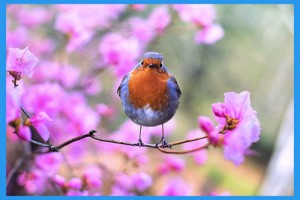 You also may want to read inspiring bird watching books to keep you interested and informed. Books like “The Big Year” by Mark Obmascik, “John James Audubon: The Making of an American” by Richard Rhodes, “To See Every Bird on Earth” by Dan Koeppel, “Birding Without Borders” by Noah Strycker, and “Wesley the Owl” by Stacey O’Brien are good for starters. Some of these books are more educational than others, but some are more inspiring. You may want to try a few different books out. You may gain a lot of insight from the various perspectives and it may empower you as a beginner Birder.
You also may want to read inspiring bird watching books to keep you interested and informed. Books like “The Big Year” by Mark Obmascik, “John James Audubon: The Making of an American” by Richard Rhodes, “To See Every Bird on Earth” by Dan Koeppel, “Birding Without Borders” by Noah Strycker, and “Wesley the Owl” by Stacey O’Brien are good for starters. Some of these books are more educational than others, but some are more inspiring. You may want to try a few different books out. You may gain a lot of insight from the various perspectives and it may empower you as a beginner Birder.
When Birding, use a quality field guide or ID card and look at the illustrations and species descriptions of bird types. ID Cards are rather limited on information and are good for children or tourists, often found in park visitor centers. Beginner guides are often arranged by bird color, while intermediate guides are usually arranged by bird shapes. Advanced guides are arranged taxonomically and require more study and a better understanding of birds. Find the appropriate field guide for your Birding level and just work your way up from there.
Regional guides like Sibley Birds East or West and the Audubon Society’s national website are great resources, too. There are also field guide apps that are readily updated, less expensive (often free), and won’t weigh you down. Do research, read blogs and publications like Bird Watcher’s Digest, and watch documentaries. There are also useful apps like the Cornell Lab of Ornithology’s Merlin Bird ID that you can download and use to help motivate you. (It’s similar to a scavenger hunt!) Sight logging with the eBird app may also be beneficial. You may also want to look into the techniques and history of professional Birders like John James Audubon and Roger Tory Peterson.
When you get the opportunity, be sure to observe cooperative birds. Things like behavior, shape, color, and general field markings are all important indicators of a species. Compare similarities of birds of the same species as well as their differences. This can help you to identify birds better in the future. Continue to make time observing difficult species of birds so as not to lose familiarity.
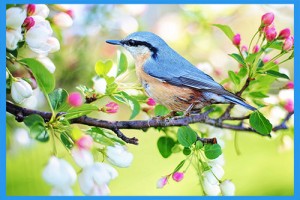 Be methodical in your observation technique. Begin with the bird’s head, then down to the breast/belly, and tail. Take note of field marks or even sketch them. If need be, start over in your process of observation. Taking notes and drawing sketches of particular bird traits can help reinforce your knowledge and assist in memory retention. Use a memory device, such as mnemonics, if need be.
Be methodical in your observation technique. Begin with the bird’s head, then down to the breast/belly, and tail. Take note of field marks or even sketch them. If need be, start over in your process of observation. Taking notes and drawing sketches of particular bird traits can help reinforce your knowledge and assist in memory retention. Use a memory device, such as mnemonics, if need be.
When you Bird, consider the time of year, the time of day, the location, and the weather, because all of these factors can play a role in what types of birds you’ll see. Get to know the common birds. These birds have a particular look, sound, and behavior. Ask yourself some questions about what they eat, where they nest, what they look like, what they sound like, and how they move. An interesting aspect of getting to know the regular birds in your area is that you’ll be familiar with them enough to notice when something unusual comes along.
Consider finding a good place to observe the birds, perhaps at a park or trail. A place where birds might get both food and water is a likely spot to find them. Also, areas where two habitats meet, like where water reaches land or when a wooded area becomes a meadow, are key Birding locations. Remember to be patient and let the birds come to you.
There are birds to be found throughout all hours of the day. Dawn and dusk are active times for many birds because their songs and calls carry more effectively out of the heat of the sun and humidity. There are birds active during the night as well. You can research what types of birds you’re interested in and schedule some time to watch them. It is also a good idea to prepare yourself beforehand, allowing a few spare minutes before having a Birding session.
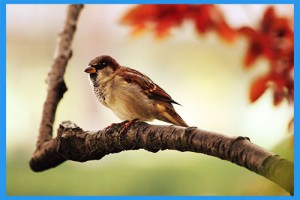 During migration and flight, birds often go where the food is, but you can take advantage of these patterns and sometimes spot an unusual species during the spring and fall seasons. It’s good practice to be conscious of your surroundings and the time of year.
During migration and flight, birds often go where the food is, but you can take advantage of these patterns and sometimes spot an unusual species during the spring and fall seasons. It’s good practice to be conscious of your surroundings and the time of year.
When actively Birding, try not to scare the birds. Let them come to you. Wear inconspicuous colors, move quietly, and stay still whenever you can. Some birds are shyer than others and may not appear until they’re more comfortable. Birding may require patience in waiting for the birds as well as patience in identifying them.
Another good idea is to keep a log book with dates, notes, sketches, bird types, and location as it may help you to better understand their patterns and anticipate their behaviors during migration.
Spend more time looking at the birds as opposed to the field book. The field book will be available after the bird leaves. Also, try your best to look at every bird that you can. You never know when you might spot something exceptional.
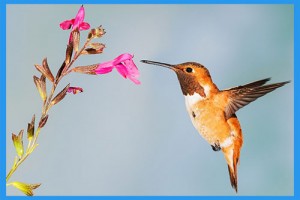 Another great resource is your fellow Birders. Ask other Birders if you need help with bird identification and techniques. Often, Birders are friendly and may even be able to loan you a pair of binoculars if need be.
Another great resource is your fellow Birders. Ask other Birders if you need help with bird identification and techniques. Often, Birders are friendly and may even be able to loan you a pair of binoculars if need be.
The benefits of Birding may include a better understanding of the native birds and your surroundings. You may notice changes in bird patterns, behaviors, and seasonal changes as well as find more appreciation in the natural world. Birding is also a low-cost activity that can be an enjoyable experience for just one individual as well as an entire group. It can offer opportunities to meet like-minded individuals through Birding clubs and the like as well.
When you’re out in the field, here are some things to remember when Birding. If you are Birding in any wildlife or national park, feeding them is against the law. Using bird calls in national parks is also illegal. Don’t disturb bird eggs and nests. Nesting birds should be left alone. Also, be careful when walking with binoculars as you can trip and fall if you’re not paying attention to your surroundings. Knowing the weather predictions for the day is also helpful, as is wearing sunscreen and using insect repellent. Always be careful and aware of your surroundings. Don’t attempt to go to dangerous or off limit locations and don’t put yourself, others, or the environment in harm’s way. Lastly, be respectful to the birds’ and their homes.
If you’re interested in Birding, why not share your experience with us in the comments? Here at Fifthroom.com, we have some products to help you get started on your backyard Birding adventure.
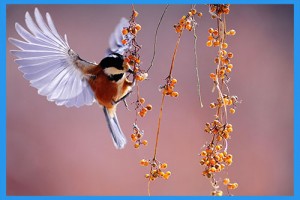
Poly Lumber Oriole Feeder
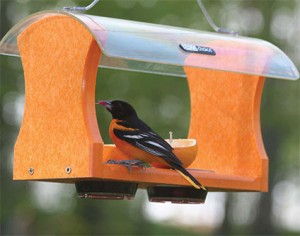
Made of Recycled Poly Lumber and weighing 5 lbs., the Poly Lumber Oriole Feeder is maintenance free and bird friendly!
View Details or check out More Bird Feeders
Cypress English Tudor Birdhouse

Inspired by the traditional English architecture, the Cypress English Tudor Birdhouse will make a cozy home for your feathered friends.
View Details or check out More Bird Houses
Ceramic Bluebird Bird Bath

Give your bird pals a spot to bathe and socialize with our Ceramic Bluebird Bird Bath. You’ll make your yard the place to be.
View Details or check out More Bird Baths
We wish you the best on all of your Birding expeditions. And, as always, don’t forget to visit www.fifthroom.com for all things outdoor decor.

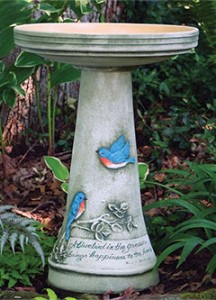
0